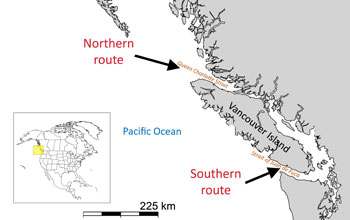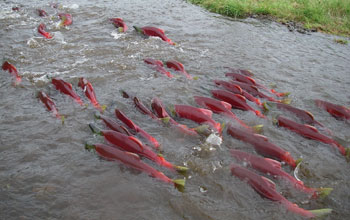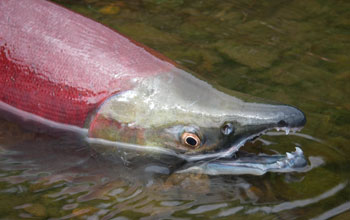
The
proportion of salmon using the northern versus southern passage to the
Fraser River in British Columbia, Canada, could be largely predicted by
the magnetic fields of these passages; the closer the magnetic field at a
passage entrance matched the field at the river mouth years before when
the fish originally swam through it, the more fish used the passage.
Credit: Nathan Putman, Oregon State University
Credit: Nathan Putman, Oregon State University
Download the high-resolution JPG version of the image. (735 KB)

When
sockeye salmon migrate from salt water to fresh water, they change
color--going from their ocean colors of mostly silver with some darker
coloration on their backs (like a lot of other ocean fish) to red when
in fresh water.
Credit: Dr. Tom Quinn, University of Washington
Download the high-resolution JPG version of the image. (986 KB)

Sockeye salmon weigh on average 8 pounds, and may reach 3 feet in length.
Credit: Dr. Tom Quinn, University of Washington
Download the high-resolution JPG version of the image. (1.2 MB)

Amazing Salmon Migrations
Credit and Larger Version
February 7, 2013
View a video
of Nathan Putnam, a post-doctoral researcher at Oregon State
University, who is working to solve some of the mysteries of salmon
migrations.
When
migrating, sockeye salmon typically swim up to 4,000 miles into the
ocean and then, years later, navigate back to the upstream reaches of
the rivers in which they were born to spawn their young. Scientists, the
fishing community and lay people have long wondered how salmon find
their way to their home rivers over such epic distances.
How do they do that?
A new study, published in this week's issue of Current Biology
and partly funded by the National Science Foundation, suggests that
salmon find their home rivers by sensing the rivers' unique magnetic
signature.
As part of the study, the research team used data
from more than 56 years of catches in salmon fisheries to identify the
routes that salmon had taken from their most northerly destinations,
which were probably near Alaska or the Aleutian Islands in the Pacific
Ocean, to the mouth of their home river--the Fraser River in British
Columbia, Canada. This data was compared to the intensity of the
Earth's magnetic field at pivotal locations in the salmon's migratory
route.
The Earth has a magnetic field that weakens with proximity
to the equator and distance from the poles and gradually changes on a
yearly basis. Therefore, the intensity of the magnetosphere in any
particular location is unique and differs slightly from year to year.
Because
Vancouver Island is located directly in front of the Fraser River's
mouth, it blocks direct access to the river's mouth from the Pacific
Ocean. However, salmon may slip behind Vancouver Island and reach the
river's mouth from the north via the Queen Charlotte Strait or from the
south via the Juan De Fuca Strait.
Results from this study showed
that the intensity of the magnetic field largely predicted which route
the salmon used to detour around Vancouver Island; in any given year,
the salmon were more likely to take whichever route had a magnetic
signature that most closely matched that of the Fraser River years
before, when the salmon initially swam from the river into the Pacific
Ocean.
"These results are consistent with the idea that juvenile
salmon imprint on (i.e. learn and remember) the magnetic signature of
their home river, and then seek that same magnetic signature during
their spawning migration," said Nathan Putman, a post-doctoral
researcher at Oregon State University and the lead author of the study.
Important results
It
has long been known that some animals use the Earth's magnetic field to
generally orient themselves and to follow a straight course. However,
scientists have never before documented an animal's ability to "learn"
the magnetic field rather than to simply inherit information about it or
to use the magnetic field to find a specific location.
This study
provides the first empirical evidence of magnetic imprinting in animals
and represents the discovery of a major new phenomenon in behavioral
biology.
In addition, this study suggests that it would be
possible to forecast salmon movements using geomagnetic models--a
development that has important implications for fisheries management.
Get out the map
Putman
says scientists don't know exactly how early and how often salmon check
the Earth's magnetic field in order to identify their geographic
locations during their trip back home. "But," he says, "for the salmon
to be able to go from some location out in the middle of the Pacific
4,000 miles away, they need to make a correct migratory choice
early--and they need to know which direction to start going in. For
that, they would presumably use the magnetic field."
Putman
continues, "As the salmon travel that route, ocean currents and other
forces might blow them off course. So they would probably need to check
their magnetic position several times during this migration to stay on
track. Once they get close to the coastline, they would need to hone in
on their target, and so would presumably check in more continuously
during this stage of their migration."
Putman says that once the
salmon reach their home river, they probably use their sense of smell to
find the particular tributary in which they were born. However, over
long distances, magnetism would be a more useful cue to salmon than
odors because magnetism--unlike odors--can be detected across thousands
of miles of open ocean.
A long, strange trip
Like
other Pacific Salmon, sockeye salmon spawn in the gravel beds of rivers
and streams. After the newly hatched salmon emerge from these beds,
they spend one to three years in fresh water, and then they migrate
downstream to the ocean.
Next, the salmon travel thousands of
miles from their home river to forage in the North Pacific for about two
more years, and then, as well-fed adults, they migrate back to the same
gravel beds in which they were born.
When migrating, salmon must
transition from fresh water to sea water, and then back again. During
each transition, the salmon undergo a metamorphosis that Putman says is
almost as dramatic as the metamorphosis of a caterpillar into a
butterfly. Each such salmon metamorphosis involves a replacement of gill
tissues that enables the fish to maintain the correct salt balance in
its environment: the salmon retains salt when in fresh water and pumps
out excess salt when in salt water.
Salmon
usually undertake their taxing, round-trip migration, which may total up
to 8,000 miles, only once in their lives; they typically die soon after
spawning.
For more information about this study, see Oregon State University's press release.
-NSF-
Media Contacts
Lily Whiteman, National Science Foundation (703) 292-8310 lwhitema@nsf.gov
Mark Floyd, Oregon State University (541) 737-0788 mark.floyd@oregonstate.edu
Mark Floyd, Oregon State University (541) 737-0788 mark.floyd@oregonstate.edu
Program Contacts
Michelle Elekonich, National Science Foundation (703) 292-7202 melekoni@nsf.gov
Principal Investigators
Nathan Putman, Oregon State University (205) 218-5276 nathan.putman@oregonstate.edu
Related WebsitesArticle about the use of magnetism by sea turtles: http://www.livescience.com/21080-loggerhead-turtle-migration.html
Press release about discovery that sea turtles use magnetism to steer when migrating around the Atlantic basin: http://www.nsf.gov/news/news_summ.jsp?cntn_id=124190
Press release about discovery that sea turtles use magnetism to steer when migrating around the Atlantic basin: http://www.nsf.gov/news/news_summ.jsp?cntn_id=124190
The National Science Foundation (NSF) is an independent federal
agency that supports fundamental research and education across all
fields of science and engineering. In fiscal year (FY) 2012, its budget
is $7.0 billion. NSF funds reach all 50 states through grants to nearly
2,000 colleges, universities and other institutions. Each year, NSF
receives over 50,000 competitive requests for funding, and makes about
11,000 new funding awards. NSF also awards nearly $420 million in
professional and service contracts yearly.
Useful NSF Web Sites:
NSF Home Page: http://www.nsf.gov
NSF News: http://www.nsf.gov/news/
For the News Media: http://www.nsf.gov/news/newsroom.jsp
Science and Engineering Statistics: http://www.nsf.gov/statistics/
Awards Searches: http://www.nsf.gov/awardsearch/
NSF Home Page: http://www.nsf.gov
NSF News: http://www.nsf.gov/news/
For the News Media: http://www.nsf.gov/news/newsroom.jsp
Science and Engineering Statistics: http://www.nsf.gov/statistics/
Awards Searches: http://www.nsf.gov/awardsearch/
The National Science Foundation (NSF)
Guillermo Gonzalo Sánchez Achutegui
ayabaca@gmail.com
ayabaca@hotmail.com
ayabaca@yahoo.com
Inscríbete en el Foro del blog y participa : A Vuelo De Un Quinde - El Foro!

No hay comentarios:
Publicar un comentario